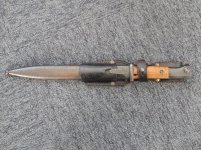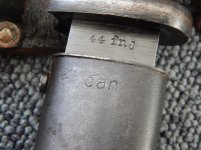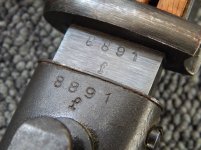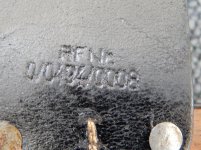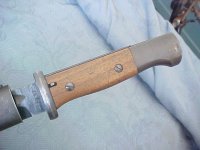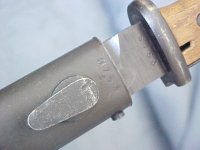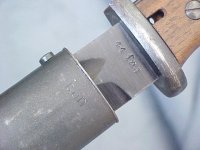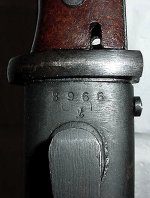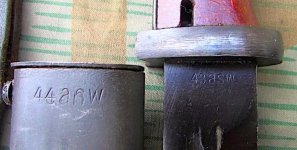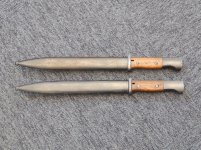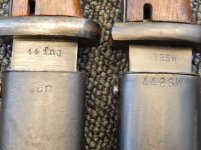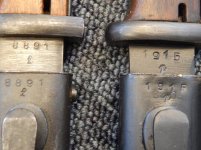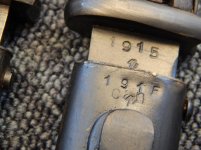
You are using an out of date browser. It may not display this or other websites correctly.
You should upgrade or use an alternative browser.
You should upgrade or use an alternative browser.
84/98 FNJ 44 in CAN scabbard
- Thread starter stabsfeldwebel2
- Start date
The "can" marking was the code for Wallmeyer, August, Maschinenfabrik und EisengieBerei, Eisenach/Thur.. My example is Sn. 8753|f. The "44 fnj"/"can" subcontract scabbard variant is a very scarce bird (even when compared to the "asw 44", rivet gripped bayonets with "can" marked scabbards). In addition, the code is only seen on the smooth side of the "fnj" scabbard variant and above the frog stud on the "asw" examples (some of the latter may have the "can" code partially ground away as well). Anytime I am at a show, etc. and happen to pick up a S84/98 T3 which turns out to be a late "44 fnj", next thing I check is the scabbard for the Wallmeyer code.
Congrats stabsfeldwebel2...that is a real score! Hopefully Andy B. can help us with the known low & high reported serial numbers/letter bloc(s), which I believe is a very short run...
Congrats stabsfeldwebel2...that is a real score! Hopefully Andy B. can help us with the known low & high reported serial numbers/letter bloc(s), which I believe is a very short run...
Last edited:
Peter S
Senior Member
for comparison, mine can be seen here
http://www.k98kforum.com/showthread.php?10713-1944-fnj-w-can-scabbard
http://www.k98kforum.com/showthread.php?10713-1944-fnj-w-can-scabbard
The "can" marking was the code for Wallmeyer, August, Maschinenfabrik und EisengieBerei, Eisenach/Thur.. My example is Sn. 8753|f. The "44 fnj"/"can" subcontract scabbard variant is a very scarce bird (even when compared to the "asw 44", rivet gripped bayonets with "can" marked scabbards). Of interest is the Wallmeyer code being italicized on the Horster contract scabbards, but in standard letters on the Coppel utilized ones. In addition, the code is only seen on the smooth side of the "fnj" scabbard variant and above the frog stud on the "asw" examples (some of the latter may have the "can" code partially ground away as well).
Have never seen an italicized can marking and would be suspicious of same. All of the can marked scabbards on both Coppel and Hörster pieces that I have observed are the standard lower case font as in the photos above. On the Coppel (44fnj) examples they have been observed in the f, g, and h blocks. These scabbards are all marked can on the reverse and serial numbered to match the bayonet. The Hörster pieces are primarily found in the 43/44asw series scattered within the s, t, u, and v blocks. A few can scabbards have also been observed in the 44asw rivet grip series within the cc and ee blocks. The Hörster scabbards are observed with the can stamp on either the obverse or reverse of the scabbard and usually with the 44asw or serial number/letter block stamped over the can. As already noted, some Hörster examples have had the original can stamping ground away (partially or totally). All of the can scabbards are rare with the most examples found in the 44fnj series, followed by the 43/44asw, and the rarest pieces being rivet gripped 44asw.
I am of the opinion that Wallmeyer only produced the scabbard shells complete with finial ball. The scabbards were finish assembled by Hörster and Coppel respectively. By this I mean the scabbards were drilled and tapped for the throat fitting and internal retention springs. And also fitted with the frog hanging hook assembly. Lastly they were stamped with the serial number and in the case of Hörster, the maker/date code. I say this as the frog hanging hooks and baseplates found on the asw bayonets are clearly made by Hörster. Likewise these parts on the Coppel scabbards were made by that firm. This also helps explain why the Hörster pieces can be found with the can marking on either side. They would not have left the Wallmeyer factory in this configuration. Much more on these issues in the book ......
Examples of can scabbards in the 43/44asw series as discussed above. Photograph one has the can marking to the reverse with date/maker code overstamped. Photograph two has the can marking to the obverse (partially ground) with the serial number and letter block overstamped. Both can markings are standard font; no italics. Both examples are in the t block. Photograph one, courtesy of a fellow forum member; two my collection.
Attachments
Have never seen an italicized can marking and would be suspicious of same. All of the can marked scabbards on both Coppel and Hörster pieces that I have observed are the standard lower case font as in the photos above... This also helps explain why the Hörster pieces can be found with the can marking on either side. They would not have left the Wallmeyer factory in this configuration. Much more on these issues in the book ......
Thanks for the corrections & clarifications, Slash. This came from the partially-ground away "can" scabbard I once had. Verified the bloc letter font with w/my Horster '44 #8410cc rivet-grip example. Never seen/knew it existed, a Horster with the Wallmeyer code on the smooth side of the 'bard. As for rarity, was unaware the Coppel variant existed until Y2K, and only knew of three or four since then. Guess one can say any S84/98 T3 with a "can" marked scabbard is a scarce one!
When the Great-Western show was terminated in 1998, and the downwards slide of collector shows began, my exposure to collectible bayonets, etc. went south as well. Only when I started to go to the SOS several years later, was I able to even try to keep abreast of what was going on (values and prices in particular). Collector-specific online forums then began to appear, and between the two, I am always seeing and/or learning something new...
Last edited:
stabsfeldwebel2
Senior Member
M1903A3
Keeper of the Def's Head
Have never seen an italicized can marking and would be suspicious of same. All of the can marked scabbards on both Coppel and Hörster pieces that I have observed are the standard lower case font as in the photos above. On the Coppel (44fnj) examples they have been observed in the f, g, and h blocks. These scabbards are all marked can on the reverse and serial numbered to match the bayonet. The Hörster pieces are primarily found in the 43/44asw series scattered within the s, t, u, and v blocks. A few can scabbards have also been observed in the 44asw rivet grip series within the cc and ee blocks. The Hörster scabbards are observed with the can stamp on either the obverse or reverse of the scabbard and usually with the 44asw or serial number/letter block stamped over the can. As already noted, some Hörster examples have had the original can stamping ground away (partially or totally). All of the can scabbards are rare with the most examples found in the 44fnj series, followed by the 43/44asw, and the rarest pieces being rivet gripped 44asw.
I am of the opinion that Wallmeyer only produced the scabbard shells complete with finial ball. The scabbards were finish assembled by Hörster and Coppel respectively. By this I mean the scabbards were drilled and tapped for the throat fitting and internal retention springs. And also fitted with the frog hanging hook assembly. Lastly they were stamped with the serial number and in the case of Hörster, the maker/date code. I say this as the frog hanging hooks and baseplates found on the asw bayonets are clearly made by Hörster. Likewise these parts on the Coppel scabbards were made by that firm. This also helps explain why the Hörster pieces can be found with the can marking on either side. They would not have left the Wallmeyer factory in this configuration. Much more on these issues in the book ......
As always Lance, you’re THE man when it comes to bayonets!
Sent from my iPhone using Tapatalk



